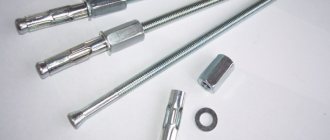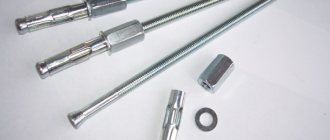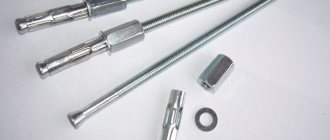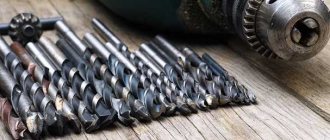We recently figured out what is the best knife handle
. There we came to the conclusion that although high-quality synthetics are better, wood looks much more aesthetically pleasing. If you properly impregnate a piece of wood, it will last for decades, and will even be passed on to your children.
So today we will tell you about the types of wood most often used to make knife handles. In general, the “correct” handle is the key to the success of any knife. It doesn’t matter what kind of steel it is made of, the most important thing is that it fits well in the palm of your hand and you can work with it comfortably.
Birch
The cheapest and most readily available material for making knife handles. Getting such a piece of wood is as easy as shelling pears - just go to any hardware store and buy a birch cutting for a shovel. This will save you from the work of selecting, drying and preparing wood. From what I can immediately remember with a simple wooden handle, these are Mora Classic knives.
Birch is perfectly processed and does not split under shock loads. This does not mean that you need to hammer in nails with a birch handle; not a single wooden handle can withstand such abuse. Our Russian knife makers very rarely use simple birch to make knife handles. At a minimum, it is Karelian, but most often it is birch burl or suvel.
Making a handle with your own hands step by step
The simplicity of the design of the knife and its handle makes it easy to make this tool with your own hands.
For example, if you have a high-quality blade with a damaged handle, you can easily update it by making a handle from scrap materials according to the algorithm given in our article.
Required Tools
As a rule, most craftsmen make knife handles from wood, although other natural and synthetic materials are also suitable for this purpose.
Based on the selected material, the tools for the job are selected. For example, for wood processing you will definitely need special impregnations (for example, linseed oil), which will protect the finished product from moisture and other negative environmental factors.
To process the material you will also need special tools. The easiest way to process wood is with a cutter, chisel or rasp, but to work with metal you will need a special vice and abrasive stones. Power tools can also be useful for processing materials of increased strength: drills, jigsaws, chisels, etc.
Requirements for size and shape
There are no clear requirements for the size of hunting knives: everyone is guided by considerations of personal convenience and the functions that the blade will perform (Figure 4).
The optimal blade length for a hunting knife is 10 cm. With the help of such a tool, you can cut up game and use it for planing wood or other purposes.
Figure 4. Variety of sizes and shapes
The minimum length of the handle of a quality knife is 11-13 cm, while the width of the finished product is determined individually, depending on the personal preferences of the future owner. As for the shape of the blade, an oval or convex handle is considered optimal for a hunting knife, which ensures the convenience and efficiency of using the tool.
Types of materials used
The types of materials for making knife handles are very diverse. For this purpose, both natural materials, such as wood or leather, and synthetic materials, such as metal, plastic or rubber, are used.
The final choice of material depends on your skills, capabilities and personal preferences. To make it easier for you to make your choice, we will provide more detailed information about each type of material that can be used to make the handle of a hunting knife.
Tree
Wood is considered one of the most popular materials for making a hunting knife handle. Typically, hardwoods such as walnut, ash, birch, beech, cherry, hornbeam, oak or maple are used for this purpose (Figure 5).
If you want to make a wooden knife handle with your own hands that is not only durable, but also original, you can use exotic types of wood. Breeds such as merbau, amaranth, bubingo or zebrano do not grow in our latitudes, but have sufficient strength and attractive appearance, and are ideal for making knife handles.
Figure 5. Options made of wood
If you don't have a suitable piece of natural wood, you can always use parquet pieces. This flooring is made from durable wood that is ideal for making hunting knife handles.
Of course, in some respects natural wood is inferior to synthetic materials in terms of wear resistance and durability, but it also has certain advantages. For example, this natural material is easy to process, it has a unique texture, and also provides reliable grip on the palm and allows you to work outdoors for a long time, even in severe frost.
Birch bark
A handle for a hunting knife can also be made from birch bark. This material is one of the simplest and most affordable, and working with it requires a minimal set of tools. The obvious advantage of birch bark handles is that they contain natural birch tar, which protects the finished product from moisture and rotting. In addition, birch bark has low thermal conductivity, so working with a knife with such a handle will be comfortable in both heat and cold (Figure 6).
Figure 6. The procedure for making a product from type-laid birch bark
To make a birch bark handle, the top layer of birch bark is used, which is cut into small pieces, glued with epoxy resin and compressed into a briquette using a vice. Thanks to such a simple design, the handle can be made in just one day. The only drawback of such a handle is that birch bark absorbs odor very well, so if you use a knife to cut game or fish, the handle will absorb these odors and it will be extremely difficult to get rid of them in the future.
Leather
Genuine leather is also a suitable material for making the handles of Finnish and other knives. As a rule, the same typesetting technology is used to produce the workpiece as for the manufacture of birch bark handles (Figure 7).
Figure 7. Leather products are comfortable and durable
Along with the obvious advantages of natural material - wear resistance, low thermal conductivity and comfort, and leather handles, there are also certain disadvantages. As with birch bark, genuine leather absorbs odors very well, so it is usually used for making tourist or camping knives that are not used for processing game or fish. In addition, if you use and store such a knife incorrectly, the leather may begin to rot and the handle will have to be replaced. Therefore, experts recommend that after each use, thoroughly rinse and dry the knife, followed by treating the handle with special protective agents for the skin or natural wax.
Plastic
Modern composites are much superior to natural materials in their performance characteristics. High-quality plastic does not absorb moisture and odors, has low thermal conductivity and fits comfortably in the hand, allowing you to wield the knife for a long time without fatigue.
Fruit trees
Good handles are made from apple, pear, cherry or plum. But it’s not worth cutting down fruit trees to make knife handles out of them. But if you need to cut down a bad or non-fruit-bearing tree on your site, then it would be a sin not to use such good, and most importantly free, material. As a last resort, you can cut the wood into blanks and sell it to knife makers.
Deciduous trees growing in our latitudes
We will not consider each tree separately, as this will take too much time. Let’s just list the tree species that our knife makers most often use:
- Oak. Bog oak is most prized;
- Rowan;
- Ash;
- Sea buckthorn;
- Beech;
- Acacia.
This is not a complete list of trees that can be used to make knife handles. The most valuable thing in any wood is the root, the root cut, all sorts of burls and burls.
What to make a knife handle from: Wood. Part 1. | Blog TS "Profile"
Wood, along with horn, was the first material that people began to use in making knives. Over several millennia, a sustainable technology for working with wood has been developed, and all possible methods of wood processing have been tried. And although today wooden handles compete with modern materials such as micarta, G-10 or carbon, the relevance of their use does not decrease. Wood, especially wood that has undergone modern processing, continues to be actively used in the production of handles; not only long-known wood species are used, but also quite exotic, rare and possessing interesting properties. 1. Hornbeam
Hornbeam (lat. Cárpinus) is a genus of small deciduous trees from the Birch family (Betulaceae). Hornbeams grow in the northern hemisphere, Asian countries and China. Only two species are known in Europe.
Hornbeam is a slow growing tree. The color of the wood in section is whitish-gray. The average density of hornbeam wood in a dry state is 750 kg/m3. Hornbeam wood is very hard and difficult to process with tools. Requires slow drying and at the same time dries out greatly in volume.
Hornbeam wood is used where high hardness, toughness, and resistance to impact loads are required. At the same time, poorly processed hornbeam can rot, while overdried hornbeam actively cracks. Often used for handles of hand tools and various sports equipment (billiard cues, golf clubs). For knife handles it is most often used in stained form.
Bog hornbeam, impregnated with resins, is less susceptible to cracking, but does not tolerate high humidity. In case of insufficient processing, during use it may change color to a paler one or the wood may begin to raise pile. These are signs that the handle should be further soaked in oil.
For these purposes, teak, linseed, tung and other oils are used. Impregnation occurs at temperatures up to 60° C and with the handle completely immersed in oil.
Traditionally, Russian manufacturers paint hornbeam black and, if properly treated, it can last for many years.
2. Karelian birch
Karelian birch (oral “Korelian birch”) is the wood of a variety of silver birch (lat. Betula pendula var. carelica), which has thickenings on the trunk (burl) and a patterned twisted wood texture.
Karelian birch is a deciduous tree, reaching 15-20 m in height. The trunk diameter reaches 40 cm. It grows in the western part of Norway and Sweden, in the southeast of Karelia, in the Baltic countries, Poland and Belarus.
The bark is white with large tubercles called “svili”. The strands form a specific type of wood in which part of the bark remains inside the thickening and a characteristic pattern is created.
Birch trees reach their maximum tortuosity when they are 5-6 years old.
Karelian birch is an anomaly caused by the “pitting syndrome” of the stem, that is, the appearance of a special “ribbing” on the trunk and is therefore relatively rare in nature. The pattern of Karelian birch wood is created as a result of the pathology of the functioning of the cambium.
The anomaly manifests itself in a large accumulation of parenchymal (elongated and pointed at the ends) cells in the thickness of the wood, which create an original pattern. Birch wood has a beautiful pattern, durability (hard and non-fragile material), and produces beautiful colors in the finish - dark brown inclusions on a light yellow background.
Stabilized hornbeam
This is generally a cool tree that can perfectly replace ebony. Hornbeam wood is impregnated with resins and becomes black. Stabilized hornbeam handles are very strong, it’s not for nothing that the British called hornbeam ironwood. Stabilized hornbeam bars are inexpensive, approximately at the same level as Caucasian walnut bars.
Eben
One of the most expensive types of wood in the world. The average age of wood maturation is 500-600 years. The most valuable is Ceylon ebony, which is black in color. The wood of this tree is hard and dense, with practically no pores. When cutting down ebony, the bark and sapwood, which makes up about 70% of the trunk, are removed from above. The remaining 30% is this very ebony tree.
Sapale
Another African type of wood, distinguished by its red tint. It has high hardness; knife handles made of this material are not subject to cracking.
In addition to solid wooden handles, craftsmen often combine different types of wood. Such handles often look more original, although it’s not always the case. The same “snake tree” looks much better in the form of a solid handle.
Handles made of birch bark can also be classified as wood.
. This is an excellent material that is not subject to rotting, does not chill your hand in the cold and does not need impregnation.
Knife handle: characteristics and properties
The design of any knife is extremely simple, because it consists directly of a blade (blade) and a handle. When purchasing, we most often pay attention to the material, sharpness and shape of the blade, leaving the handle without attention. This approach is incorrect, since an awkwardly shaped handle can nullify all other advantages of the product.
Figure 1. The shape of the handle directly affects the ease of use of the knife.
The ease of use of the knife, its maneuverability and operational efficiency will depend on the correctly selected shape and size of the handle. The selection of materials also plays an equally important role. For example, if you are going to use the tool primarily outdoors, it is better to choose a product with a handle made of durable and wear-resistant material - deer antler, wood or plastic. For home use, knives with handles made of plywood and other lightweight materials are suitable, which will help you use the knife for a long time without fatigue (Figure 1).











